Photo
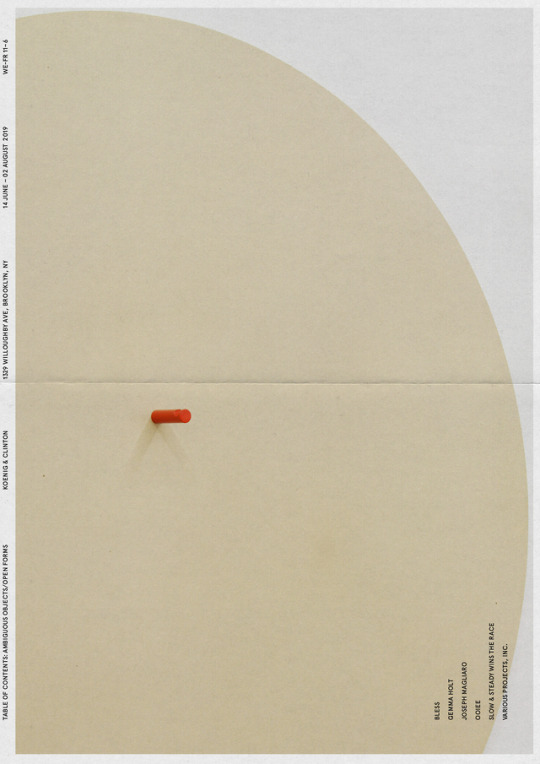
For the summer of 2019, Koenig & Clinton has invited me to produce a new iteration of Table of Contents at its Brooklyn-based gallery. The installation will run for approximately six weeks and incorporate objects and artifacts from various TOC projects, along with recent work by a few of our past collaborators: Desirée Heiss and Ines Kaag of BLESS, Gemma Holt, Matt Olson of OOIEE, Mary Ping of Slow and Steady Wins the Race, and Elizabeth Beer and Brian Janusiak of Various Projects, Inc. For the installation, a series of display panels in different shapes with various arrangements of hooks has been created. These act as “open forms” or invitations to be activated by participating artists.
The title of the show—Ambiguous Objects/Open Forms—expresses an ongoing interest in objects that refuse to sit easily to one side of the border held up between the spheres of art and design, the useless and useful, and the strange and familiar. We’re fond of work that demonstrates that such dichotomies are untenable, and that the symbolic “openness” typically reserved for works of art and denied to “products” is simply a matter of preference and prejudice in the selection of good examples. In response to David Hockney’s pithy suggestion that “art has to move you and design does not, unless it’s a good design for a bus,” we propose that all objects have the capacity to incite affective states, whether through wit (Slow and Steady’s thoughtful reinterpretation of fashion icons), surprise (Gemma Holt’s use of material experimentation to belie expectation), participation (Bless’s call to experience everyday adventures into the uncanny), transformation (Various Projects’ shrouding of the industrial and organic), or conversation (OOIEE’s recasting of found art-historical forms).
In addition to this focus on ambiguous objects, the installation highlights our concern with spaces that challenge the behaviors and relationships typically understood to be appropriate within them. TOC has always owed a bit of gratitude to Oskar Hansen, whose notion of “Open Form” was conceived as an antidote to Modernist insistence on a hierarchical division of space, category, and function, and instead sought to provoke interactions between people that would break from the model of the isolated genius/hero dictating the program of a space to a public, and instead look toward achieving a non-monumental, process-based, collaborative sense of identity-in-community.
Rather than observe known codes of conduct, Open Form proposes that we take a chance, that we approach space without a fixed view of its borders and risk encountering others on uncertain ground. How does one behave in a shop that’s installed in a gallery? I guess we’ll find out.
12 notes
·
View notes
Photo

4 notes
·
View notes
Photo

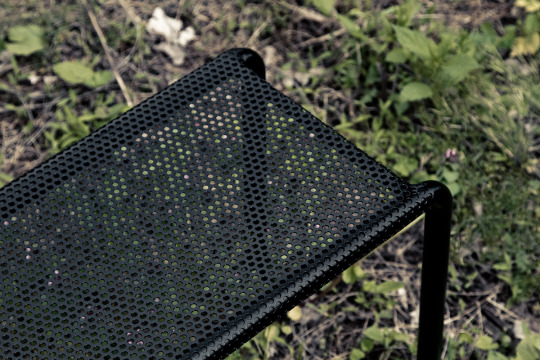

Foundation No. 2 - Bench in nero marquina marble and powder coated steel. Designed by Joe Magliaro of Table of Contents for Bloc Studios. Released during New York Design Week, Sight Unseen Offsite, 2016.
4 notes
·
View notes
Photo


Foundation No. 1 - Chair in bianco carrara marble and powder coated steel. Designed by Joe Magliaro of Table of Contents for Bloc Studios. Released during New York Design Week, Sight Unseen Offsite, 2016.
11 notes
·
View notes
Photo

Hideout @ Table of Contents exhibition statement by Alec Recinos:
‘Those things which occur to me, occur to me not from the root up but rather only from somewhere in the middle. Let someone then attempt to seize them, let someone attempt to seize a blade of grass and hold fast to it when it begins to grow only from the middle.’ Why is this so difficult? The question is directly one of perceptual semiotics. It’s not easy to see things in the middle, rather than looking down on them from above or up at them from below, or from left to right or right to left: try it, you’ll see that everything changes. It’s not easy to see the grass in things and in words.
- Gilles Deleuze and Félix Guattari
Four walls, an elevated ceiling, parquet or concrete floors, movable dividers, and above all, an abundance of white. As the archetypal gallery design, the White Cube has come to consume the exhibition space. Growing concomitant with modernism, the White Cube represents a stripping down, the attempt to shed all external context and allow only the eternal, autonomous values of art to shine through. Even the viewer becomes an intruder in this pristine sanctuary of art. The artist and writer Brian O’Doherty, in his seminal series of essays, “Inside the White Cube,” describes this ideology as culminating not in the gallery space, but rather in the installation shot. “Here at last, the spectator, oneself is eliminated,” allowing for an uncontaminated, though necessarily distant and removed, experience of art and viewing.
It’s not that the White Cube is without its merits—is the frenetic bricolage of the salon really preferable?—but needless to say, it can feel a little stuffy. During the 1990s, a new type of work began to appear that the curator and critic Nicolas Bourriaud called relational aesthetics. Relational aesthetics does away with the love of the pure so intrinsic to the White Cube and instead views the work of art as a social interstice, bringing the outside in, and taking the everyday context as its focus. Soup, dancing, and even just hanging out: these materials, so prominent in works of relational aesthetics, also describe Hideout. No one aspect overshadows another—for Hideout the photo is just as important as the pho. Not quite a gallery, and not quite a party or event, Hideout is somewhere in between, combining contexts and turning ambiguities into possibilities. Hideout at Table of Contents takes place as a weeklong exhibition of shifting forms and events, between Sunday, January 24 and Friday, January 29. Bookended by the opening of a group exhibition featuring work by Jacob Gevalt, Paul Savovici, and Shohei Takasaki, and a closing party with DJs Maxx Bass and Alex Asher Daniel, the in-between is in flux, continuously in the process of becoming something else. The show passes through forms and configurations, as the fixtures are reworked and the environment reimagined, and hosts a variety of events, including workshops, screenings, and installations. There’s no static form; meaning is on the move.
If the contemporary gallery is a White Cube, Table of Contents might be more like the Necker Cube. An assemblage that exceeds the sum of its parts, the Necker Cube transforms twelve lines, into a coherent, though unstable, visual system. As the viewer changes perspective, the shape and orientation of the cube shifts as well. It’s never possible to give a final description for the cube, it’s always somewhere in between, in the midst of a shift. When speaking of Table of Contents, there is a reluctance to describe it simply as a store. It has always been, at the same time, something else: a studio, a gallery, an environment. Though the Chinatown storefront is closing, there’s no end in sight. Both Table of Contents and Hideout act like grass.
As described by philosopher Gilles Deleuze, “not only does grass grow in the middle of things but it grows itself through the middle... Grass has its line of flight and does not take root.” Table of Contents existed long before its fixed address as an itinerant experience and ethos, the storefront was simply something in the middle, a stop along the way. Hideout too, never promised something stable. It appears, briefly, before fading into the night. Above all, disappearance promises the possibility of return. Though at first glance it might seem like an end, take another look. We’re only in the middle.
The other way of beginning again, on the other hand, is to take up the interrupted line, to join a segment to the broken line, to make it pass between two rocks in a narrow gorge, or over the top of the void, where it had stopped. It is never the beginning or the end which are interesting; the beginning and end are points. What is interesting is the middle.
- Gilles Deleuze
5 notes
·
View notes
Photo
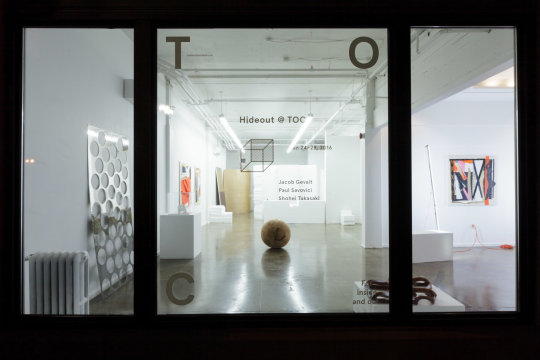
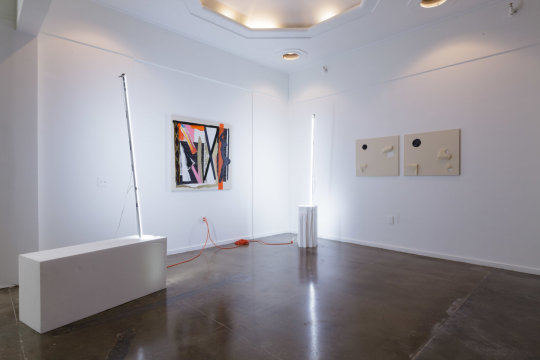



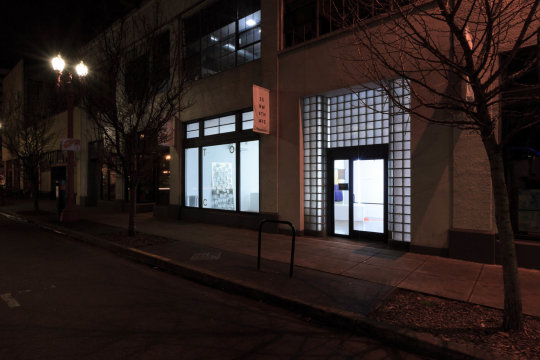
Some installation shots from our nameless exhibition and exploration of in-betweenness that took place in January. Rather than fix our position to a name, images of a Necker cube float throughout the exhibition spaces and communications, highlighting our belief that the distinction between inside and outside is illusory, a perspective that is subject to continual slippage and redescription.
Curated by Johnny Le/Hideout. With work by Jake Gevalt, Paul Savovici, and Shohei Takasaki. Exhibition concept/design by Joe Magliaro. (Photos: Johnny Le)
12 notes
·
View notes
Photo
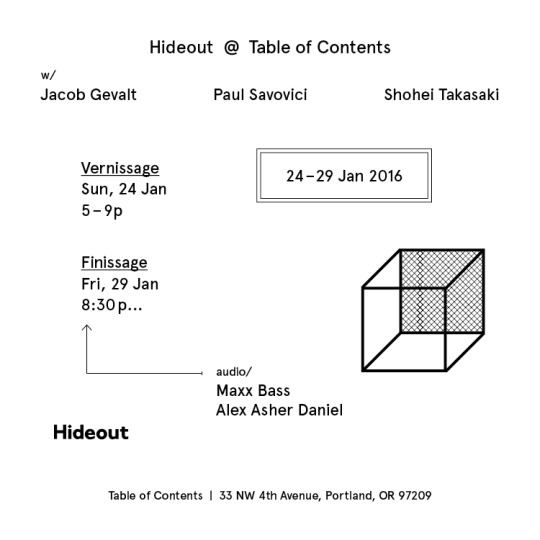
Long before opening the Chinatown storefront, Table of Contents existed as an itinerant experiment, drawn towards the idea of extending the retail environment and bringing it into a dialogue with other fields. Hideout too, comes from a similar background, combining art, music, and food into a nomadic curatorial experience. Hideout at Table of Contents acts as a natural meeting ground, where convention is set aside, barriers lowered, and new possibilities arise. Art breaks out of the White Cube, intermingling with food and fashion, while DJs and a dance floor provide a common rhythm, turning crowd into community.
Hideout at Table of Contents takes place as a week-long exhibition of shifting forms and events, between Sunday, January 24 and Friday, January 29. Bookended by the opening of a group exhibition featuring work by Jacob Gevalt, Paul Savovici, and Shohei Takasaki, and a closing party with DJs Maxx Bass and Alex Asher Daniel, the in-between is in flux, continuously in the process of becoming something else. The show passes through forms and configurations, keeping the environment open to change and experiment. Custom scents made by Maak Lab drift through, the fixtures are reworked and the environment is reimagined by TOC Studio. A variety of events, including workshops, screenings, and installations, occur, opening the exhibition to the public and inviting the outside in for one last time in Portland.
text: Alec Recinos
3 notes
·
View notes
Photo
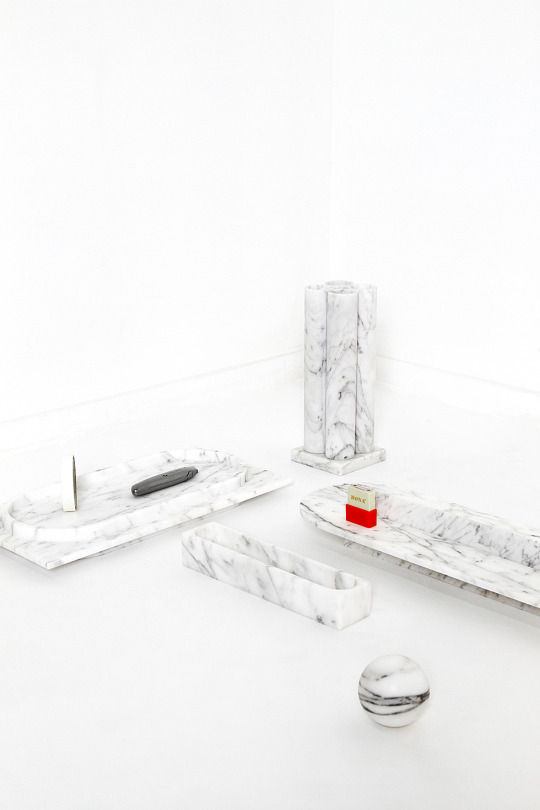
Bloc Studios Collection No. 1 “Marmo Domestico” - available at Table of Contents.
6 notes
·
View notes
Photo




Some images from our recent Meta Memphis installation.
In 1987 Ettore Sottsass and the cadre of global designers working collectively as Memphis announced that they would no longer develop new work under that banner. The movement launched at Milan’s Arc ’74 showroom in 1981 came to a close. The legacy of Memphis, and the organization responsible for its preservation and continued distribution did, however, live on.
This organization, Memphis s.r.l., was formed in June of 1981, several months after the initial meetings at which the founding members of Memphis planned their opening salvo into the field of contemporary design. Its mission was to provide the funding and distribution necessary to realize a collection of commercial products free of any precedent or proven market viability. Its forward-looking benefactor, Ernesto Gismondi, took on the role of president and majority shareholder of the new organization.
The departure of the original team of designers who had launched the Memphis movement left the company in a challenging position. The initial collective had effected such a remarkable upheaval in contemporary culture that to continue the project without them would be unthinkable. It was thus determined that for Memphis to continue, it would have to do so in a new form, under a new name: Meta Memphis.
To distinguish this new iteration, art director Carlotta De Bevilacqua and gallerist Giorgio Persono were selected to invite a cast of contemporary artists to collaborate on a collection of functional objects. Ten artists—Alighieri e Boetti, Pier Paolo Calzolari, Sandro Chia, Joseph Kosuth, Maurizio Mochetti, Mimmo Paladino, Michelangelo Pistoletto, Susana Solano, Lawrence Weiner, and Franz West—were invited to contribute to the first collection, which was exhibited at the Palazzo Querini Stampalia in Venice from June 1-18, 1989. A second collection was produced in 1991 with new work from many of the initial contributors, as well as additional artists, including Marco Bagnoli, Mathis Esterhazy, Joseph Kosuth, Sol LeWitt, Gerhard Merz, Juliao Sarmento, and Bill Woodrow.
The Meta Memphis collection is a departure from the original Memphis project in that many of the pieces have been limited to editions of 25, rather than remaining uneditioned consumer products. There is a continuity, however, in the spirit with which Meta Memphis approaches objects, a spirit that Barbara Radice describes as an awareness that “an object exists as a system of signs, as a catalyst of emotions, as a representation of a cultural state, as a container of values or information that one wants to possess, as an active presence, a reassuring wink—in other words, as an instrument of communication.”
#Meta Memphis#Table of Contents#Bill Woodrow#Lawrence Weiner#Ettore Sottsass#Barbara Radice#Ernesto Gismondi#Carlotta De Bevilacqua#Giorgio Persono
8 notes
·
View notes
Photo
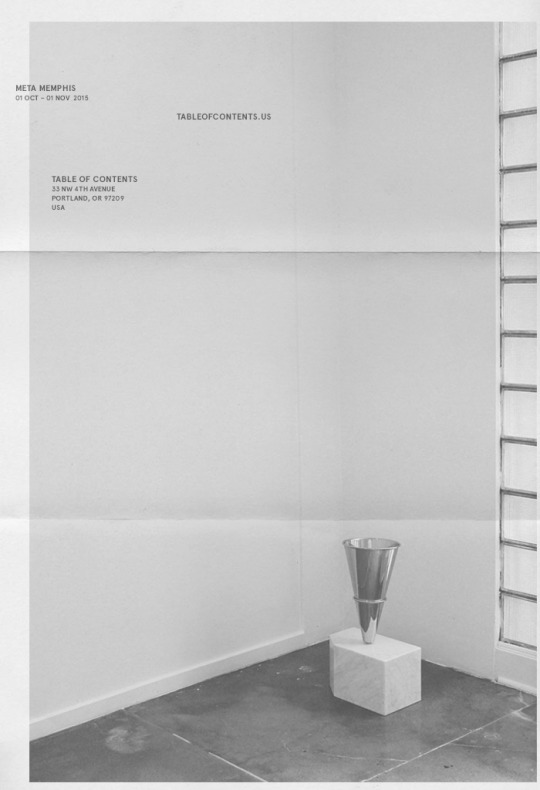
Rarely seen pieces and catalogs from the 1989/91 Meta Memphis collections will be on display through the month of October.
Opening Thursday, 01 October 5-8pm.
41 notes
·
View notes
Photo

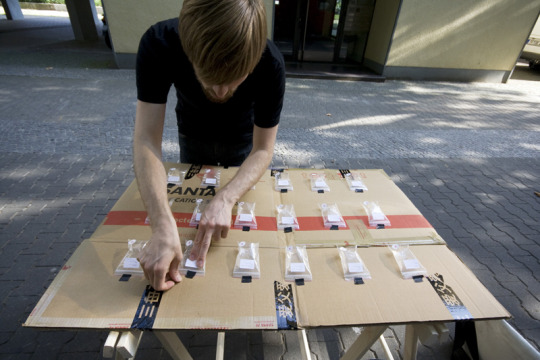

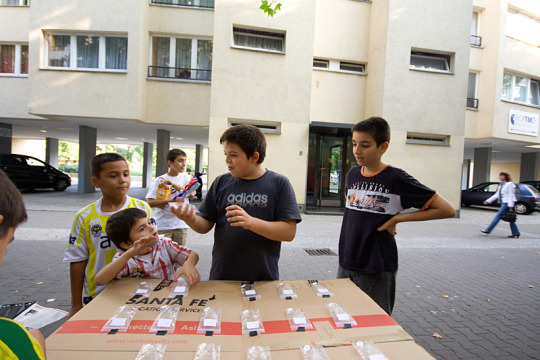
In 2008 we started a project called Table of Contents as an occasional platform for experimenting with the retail encounter. We would set up a make-shift table in Berlin’s public squares and markets, and attempt to sell a single object, often in a small edition, for a day, maybe two. The objects we sold varied: a significant book, a set of trestle legs like the ones employed by our own table, a series of plastic bags filled with air gathered from the sites of the 2008 Olympic Games in Beijing...
After moving to Portland in 2009, we began to consider how Table of Contents could develop in a new location. We settled on the idea of expanding the project with a more permanent space, a more “traditional” retail environment. But we were committed to the notion that the goal of running a shop should be similar to that of producing a magazine—the formation of a record of ideas, objects, and people that add up to a personal essay on the contemporary moment. Barbara Radice’s introduction to the premiere issue of Terrazzo has been something of a guidepost for us on this matter, and since we can’t say it better, we’ll let her do the talking:
"Doing a magazine is like writing a book or making a movie; you never know what you'll end up with and not knowing is part of the amusement. You start because you think you have something to say, something urgent or different or new, something very important, maybe even vital. What you want to communicate is not necessarily a thought, a line of argument or an idea with a beginning and an end, but more often—as now—a mood, an attitude, a predilection of the soul, a vision bearing the faintest blur of utopia."
Our vision for TOC is shifting this fall; rather than offering a selection of seasonally-themed objects, we will be presenting a series of exhibitions. In a sense, we’ll be returning to the origins of TOC: a single object or related series of objects will be displayed for a set period of time. These exhibitions will draw from historical, contemporary, and newly-developed works bordering between art and design.
But before we begin, we’ll be closing our doors from August 15 through early-September to refresh the space and prepare for TOC’s new project-oriented program. We will reopen with an installation of works commissioned in the late 1980s and early 90s by the seminal Italian design project, Memphis Milano. After officially ending the production of Memphis in 1987, this work, which was launched under the banner of "Meta Memphis," marked the beginning of the movement's second act. What comes next? the work seems to ask—an appropriate question as we begin this new chapter for TOC.
9 notes
·
View notes
Photo
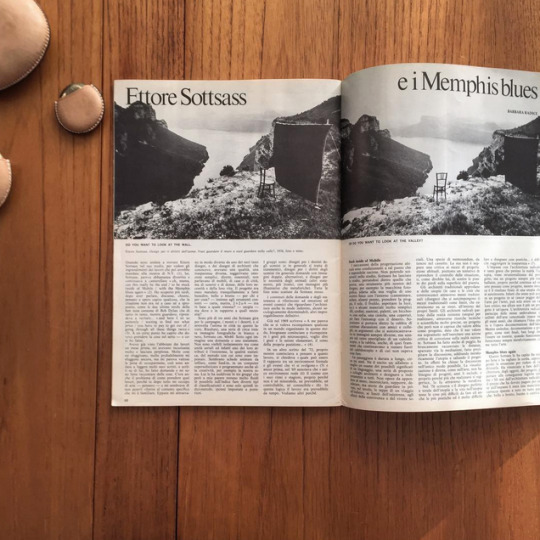
I've always assumed that the Memphis origin story (the spontaneous naming bit) was quite likely apocryphal, and this essay (Data No. 23, Oct/Nov 1976) by Barbara Radice does seem to point in that direction: she recounts interviewing Sottsass for the piece through his repeated interruptions to recite lyrics from the Bob Dylan tune "Stuck Inside of Mobile..." and then uses those lyrics as the organizing principle for the essay and her analysis of Sottsass' work. Which leads me to think that when December 1980 came around, it wasn't by chance that Blonde on Blonde was on the turntable...
Update: The piece can be read online here.
37 notes
·
View notes
Photo
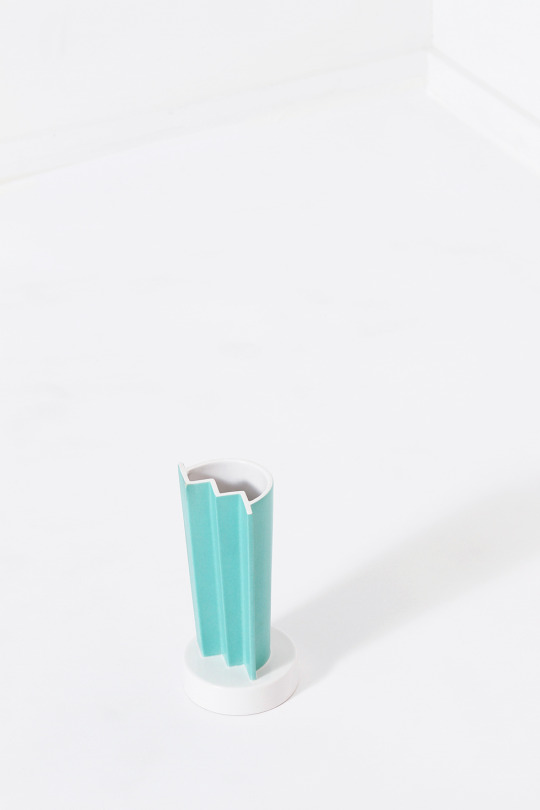
Vase by Ettore Sottsass/Alessio Sarri - available in store at Table of Contents.
21 notes
·
View notes
Photo

in the sun
18 notes
·
View notes
Photo

Max Lamb
8 notes
·
View notes
Photo

Bless N°28 Fat Knit Hammock
723 notes
·
View notes
Photo
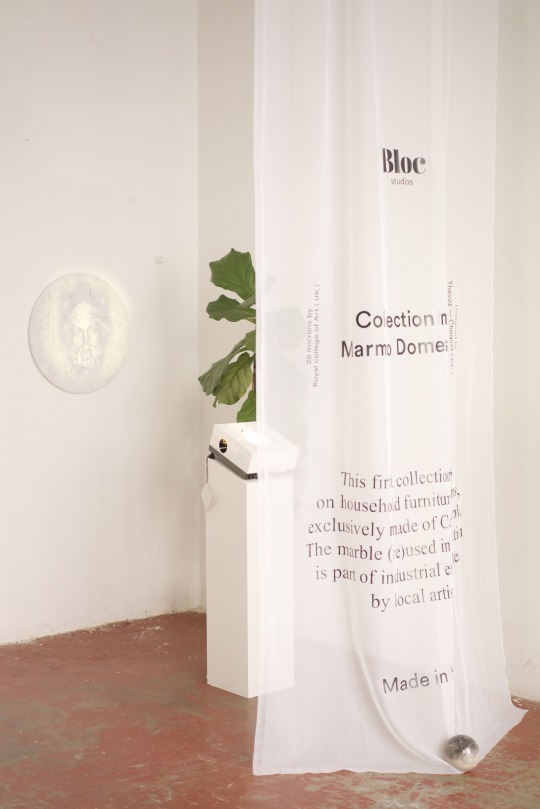

Bloc studios is an Italian brand, founded in 2014 and directed by Sara Ferron Cima / Massimo Ciuffi BLC Carrara srl*, with the desire to transform natural stone into thoughtful everyday objects. Based on the philosophy that every single bloc(k) conceals a story, Bloc celebrates the natural design diversity of Carrara marble by creating objects that are sincere to modern form and function.
P: Devan Elias
9 notes
·
View notes